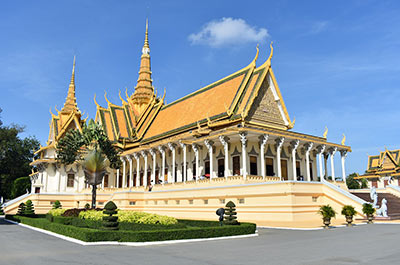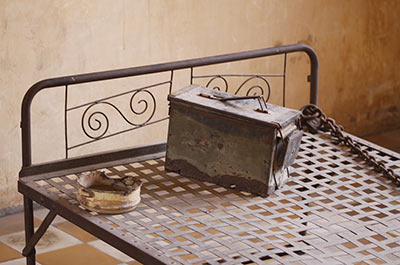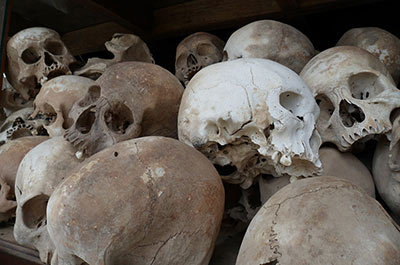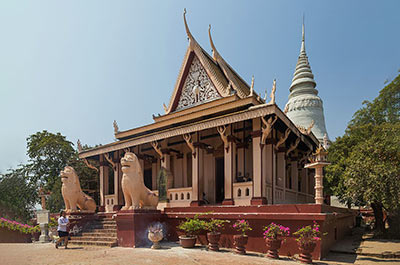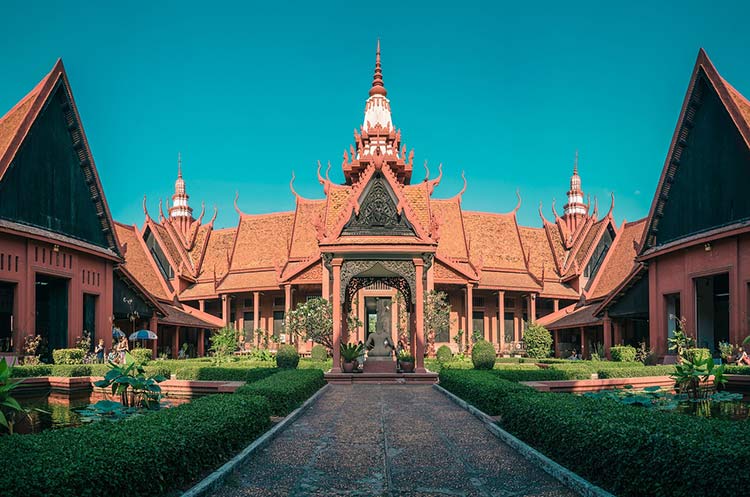
National Museum of Cambodia
Large collection of Khmer art
The National Museum of Cambodia in Phnom Penh is Cambodia’s largest historical museum. It houses one of the largest collections of Khmer art spanning from prehistory to the early 20th century. On exhibit are items as ancient Sanskrit inscribed steles, Buddhist and Hindu sculptures, ancient household utensils and items used for religious ceremonies.
Most exhibited items are labeled with a brief description in English. To get more detailed information, hire a guide or get the audio guide.
Khmer style building
The museum building was designed by French architect George Groslier, who later became the first curator of the museum. Construction of the traditional Khmer style building started in 1917. The museum opened its doors in 1920. The National Museum was closed during the reign of the Khmer Rouge from 1975 until 1979.
Galleries
The museum is divided into galleries.
- Stone art galleries
On exhibit are stone works of art from the 6th (Phnom Da style) to 13th century (Bayon style), including inscriptions, sculptures, deeply cut reliefs and bas reliefs from ancient Khmer temples for Buddhist and Hindu worshipping. Most works are sandstone. - Bronze art galleries
Bronze Buddhist and Hindu sculptures and ceremonial and secular objects from the 7th to the early 20th century. - Ethnographic art galleries
Cultural objects from the 19th until the 20th century. - Ceramics art galleries
A collection of ceramics from prehistory (5000 BC) to the Angkor period. Among others items from excavations at Angkor Borei, an ancient Khmer capital. Both glazed and unglazed ceramics used for decorative purposes, religious ceremonies and objects used in daily life. - Post Angkor Buddha galleries
Buddha statues made of wood, painted with colorful lacquer and decorated with ornaments such as pearls, glass and gems.
Prehistory
The National Museum of Cambodia exhibits items from the prehistoric era. Among them are stone and bronze weapons and tools as well as ancient ceramics from several prehistoric sites around Cambodia including Kampong Cham.
Pre-Angkor period
From the era predating Angkor, the museum displays Khmer stone inscriptions dating back to the early 6th century discovered in a hill named Phnom Da near Angkor Borei (Funan Kingdom), carved in blocks of sandstone. Other exhibits include depictions of Hindu and Buddhist deities.
Angkor period
The National Museum of Cambodia houses a great number of statues and lintels recovered from Angkor temples in various styles from various Angkor eras. The Angkor empire reached the peak of its architecture and art during the 12th century (the Angkor Wat style), when sanctuaries as Angkor Wat and Phimai were built.
On exhibit are statues of deities, bas reliefs and detailed ornamentation.
Post-Angkor period
In the post-Angkor period, wood instead of stone was used to create images of the Buddha. A layer of lacquer was applied for decorative purposes and to protect the wood from decomposing.
On display are both Hindu and Buddhist art such as lintels and bas reliefs showing scenes from the life of the Buddha and Hindu Gods as well as wooden statues of divinities.
The Hindu art works depict Gods and deities like Brahma, Vishnu, Shiva, Ganesha, Garuda and Nandi the sacred bull. The Buddhist art works depict the Buddha and the Bodhisattva Lokeshvara.
Bronze objects
Bronze items in the museum date from the 7th to 20th century. On display are bronze cast items as weapons, tools, ornaments, cast of Hindu and Buddhist divinities as well as objects used in religious ceremonies. One of the most important pieces on display in the National Museum is a 11th century bronze cast of the Reclining Vishnu.
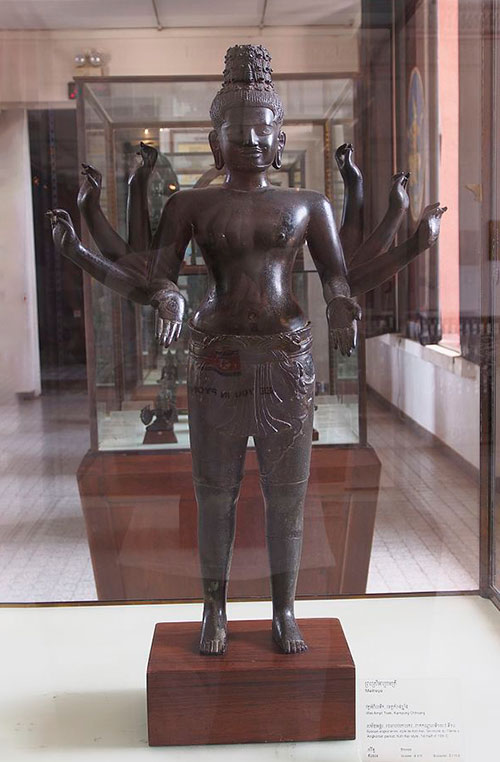
Photo by Clay Gilliland (CC BY-SA 2.0)
Ceramics
The ceramics gallery exhibits ceramics from prehistory to the Angkor period. Ceramics were mainly used for cooking and to store various items. On display are among others decorated terracotta pots and glazed ceramics in various colors from the Angkor period.
Highlights
Although the National Museum of Cambodia exhibits many beautiful and unique items, a few stand out. One of them is a statue of King Jayavarman VII from the late 12th century, discovered at Angkor Thom. Another is a bronze cast of the Reclining Vishnu from the 11th century.
Conservation
The National Museum of Cambodia works to restore and conserve historic Khmer art. Attached to the museum are three conservation workshops where staff work on stone, ceramics and metal objects to prevent further decay and to restore them.
Central courtyard
The central courtyard is a pleasant place to take a rest and relax for a while. You can get coffee and other drinks at the small café.
Opening hours
The museum opens daily from 8 am until 5 pm.
The ticket office closes at 4:30 pm.
Location
The National Museum of Cambodia is located on the corner of Street 13 and Street 178 in the center of Phnom Penh right next to the Royal Palace.
How to get there
Get to the museum by taxi, tuk tuk or cyclo.
It’s just a few minutes walk from the Royal Palace.
Entrance fee
Ticket prices at the museum are:
Adult rate: Age 18 and above, Child rate: Age 10 - 17, Toddler rate: Age under 10
Audio guides in several languages including French and English.
Guides in Khmer, English, French, Spanish and Japanese.
Photography inside the museum is not allowed.
Please follow the museum dress code and keep knees and shoulders covered.
Also in Phnom Penh:
